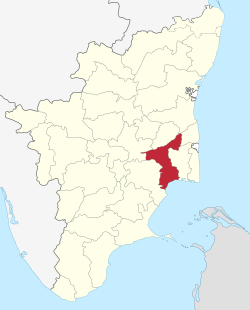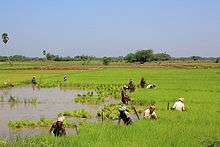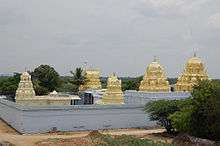Thanjavur district
| Thanjavur district தஞ்சாவூர் மாவட்டம் Thanjai Mavattam | |
|---|---|
| district | |
|
Rural landscape near Peravurani | |
| Nickname(s): Thanjai Jilla/தஞ்சை ஜில்லா | |
 Location in Tamil Nadu, India | |
| Coordinates: 10°47′8.16″N 79°8′24.36″E / 10.7856000°N 79.1401000°ECoordinates: 10°47′8.16″N 79°8′24.36″E / 10.7856000°N 79.1401000°E | |
| Country |
|
| State | Tamil Nadu |
| Municipal Corporations | Thanjavur |
| Headquarters | Thanjavur |
| Talukas | Kumbakonam, Orathanadu, Papanasam, Pattukkottai, Peravurani, Thanjavur, Thiruvaiyaru, Thiruvidaimarudur. |
| Government | |
| • Collector | A. ANNADURAI IAS |
| • Superintendent of Police | R Sudhakar IPS |
| Population (2011) | |
| • Total | 2,405,890 |
| Languages | |
| • Official | Tamil |
| Time zone | IST (UTC+5:30) |
| PIN | 613xxx |
| Telephone code | 04362,0435 |
| ISO 3166 code | [[ISO 3166-2:IN|]] |
| Vehicle registration | TN-49,TN-68[1] |
| Website |
thanjavur |
Thanjavur District is one of the 32 districts of the state of Tamil Nadu, in southeastern India. Its headquarters is Thanjavur. As of 2011, Thanjavur district had a population of 2,405,890 with a sex-ratio of 1,035 females for every 1,000 males.
Geography


The district is located at 10°05′N 79°10′E / 10.08°N 79.16°E in Central Tamil Nadu bounded on the northeast by Nagapattinam District, on the east by Tiruvarur District, on the south by the Palk Strait, of Bay of Bengal on the west by Pudukkottai District, and on the north by the river Kollidam, across which lie Tiruchirappalli and Perambalur districts.
Demographics
According to 2011 census, Thanjavur district had a population of 2,405,890 with a sex-ratio of 1,035 females for every 1,000 males, much above the national average of 929.[2] A total of 238,598 were under the age of six, constituting 121,949 males and 116,649 females. Scheduled Castes and Scheduled Tribes accounted for 18.91% and .15% of the population respectively. The average literacy of the district was 74.44%, compared to the national average of 72.99%.[2] The district had a total of 605,363 households. There were a total of 974,079 workers, comprising 117,321 cultivators, 327,673 main agricultural labourers, 26,430 in house hold industries, 363,060 other workers, 139,595 marginal workers, 12,592 marginal cultivators, 87,688 marginal agricultural labourers, 4,770 marginal workers in household industries and 34,545 other marginal workers.[3]
Economy
Agriculture
This district lies at the Kaveri delta region, the most fertile region in the state.[4] The district is the main rice producing region in the state and hence known as the Rice Bowl of Tamil Nadu.[5] Kaveri River and its tributaries irrigate the district. Apart from paddy, farmers here grow coconut and sugarcane and it is the largest producer of coconut in Tamil Nadu.Being an agrarian economy, industrial growth in the district is mainly confined to agro-based industries. A large number of Rice mills, Oil mills are spread over the district.
Tourism
Karanthai Jain Temple

Karanthai Digambar Jain Temple was built 1000 years ago is one of the famous Jain temples in Tamil Nadu.The primary deity in this Jinalaya is Shri Adinath Swamy(Rishabh dev), first tirthankar of Jainism. The other deities are Goddess Padmavati Yakshi, Nava Graha are installed. In addition few alloy idols of Thirthakars, Yakshas, and Yakshis were seated. Thirthankar idols, 24 Jinars big and small stone icons are also there. Festivals celebrated are Akshaya Tritiya,Mahavir Jayanti,Diwali,Jinaratri and Vasant Panchami.
Peruvudaiyaar Temple
Peruvudaiyaar Temple, built by the Cholas and a UNESCO World Heritage Site is located at Thanjavur. The green paddy fields and the Kaveri river provide for picturesque spots in the district.
Airavateswara temple near Kumbakonam is also a UNESCO declared World Heritage site and another major tourist attraction in the district.
Flora
Thanjavur flora were explored and studied by Dr. Ragupathy in 1992.[6]
See also
References
- ↑ www.tn.gov.in
- 1 2 "Census Info 2011 Final population totals". Office of The Registrar General and Census Commissioner, Ministry of Home Affairs, Government of India. 2013. Retrieved 26 January 2014.
- ↑ "Census Info 2011 Final population totals - Thanjavur district". Office of The Registrar General and Census Commissioner, Ministry of Home Affairs, Government of India. 2013. Retrieved 26 January 2014.
- ↑ http://drought.unl.edu/pubs/dnn/arch9.pdf
- ↑ "Thanjavur".
- ↑ Ragupathy, S. Flora of Thanjavur District. Ph.D. thesis. Centre for Advanced Study in Botany. Madras, India, University of Madras 550 pp. 1992.
External links
| Wikimedia Commons has media related to Thanjavur district. |
| | |||||||||
|---|---|---|---|---|---|---|---|---|---|
| Rank | Taluk | Pop. | |||||||
.jpg) Thanjavur  Kumbakonam |
1 | Thanjavur | Thanjavur taluk | 290,724 | |||||
| 2 | Kumbakonam | Kumbakonam taluk | 167,098 | ||||||
| 3 | Pattukkottai | Pattukkottai taluk | 65,553 | ||||||
| 4 | Adiramapattinam | Pattukkottai taluk | 31,066 | ||||||
| 5 | Peravurani | Peravurani taluk | 21,035 | ||||||
| 6 | Papanasam | Papanasam taluk | 16,397 | ||||||
| 7 | Madukkur | Pattukkottai taluk | 15,436 | ||||||
| 8 | Thiruvaiyaru | Thiruvaiyaru taluk | 14,535 | ||||||
| 9 | Vallam | Thanjavur taluk | 14,495 | ||||||
| 10 | Ayyampettai (Thanjavur district) | Papanasam taluk | 14,202 | ||||||